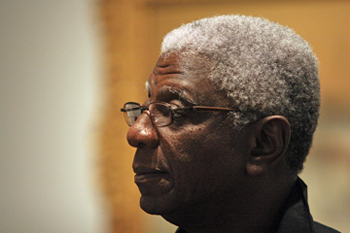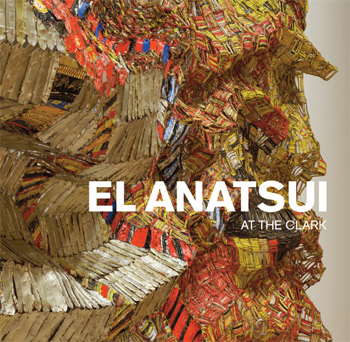
June 12–october 16, 2011
ABOUT THE artist
El Anatsui was born in 1944 in Anyako, Ghana. After earning a Bachelor’s Degree in Sculpture and a Postgraduate Diploma in Art Education from the University of Science and Technology in Kumasi, Ghana, he became Professor of Sculpture at the University of Nigeria, Nsukka, where he taught from 1975 until his retirement in 2008. Anatsui’s work has always been clearly and directly linked to traditional African art. His first sculptures were made of wood, carved and painted to resemble artifacts commonly found in African centers and marketplaces. In the late 1990s he began to work with the rigid materials for which his art is best known today: liquor bottle tops and metal foil from bottlenecks woven together with stiff copper wire to create large sculptural works. This change in materials, as well as in method and practice, has solidified Anatsui’s work as part of a twenty-first-century postmodern tradition, while simultaneously anchoring it within the tradition of his native culture.
Combining traditional African history and culture as well as Western art practices, Anatsui draws on his environment, both natural and manmade, as a source of material and inspiration. The liquor bottle tops and metal foil with which he begins his sculptures are transformed into shimmering, seemingly soft and pliant cloth-like structures resembling tapestries. The contrast between the coarseness of the individual elements that comprise his work and the striking final result implies an attention to contemporary political and social issues of transcendence, waste, recycling, and consumption. At the same time, the works are full of references to African cultural traditions such as weaving, Ghanaian kente cloth, and adinkra.
Anatsui exhibited in the Venice Biennale (1990 and 2007) and was included in the Johannesburg Biennale in 1995 as well as the Gwanju Bienniale in South Korea in 2004. He was included in the anthology exhibition Africa Remix, which toured Düsseldorf, London, Paris, Tokyo, and other cities in 2006–7. His work is in numerous public and private collections including the British Museum, Centre Georges Pompidou, the Metropolitan Museum of Art, Museum Kunst Palast, Nigeria National Art Gallery, The Museum of Modern Art, and the Smithsonian Institution. A retrospective of Anatsui's work, organized by the Museum for African Art, currently is touring in the United States.


El Anatsui at the Clark
El Anatsui in conversation with Chika Okeke-Agulu
with an essay by Alisa LaGamma
The Ghanaian-born sculptor El Anatsui is one of the most significant artistic innovators of our time, merging personal, local, and global concerns in his visual creations. By weaving together discarded aluminum tops from Nigerian liquor bottles, Anatsui creates large-scale sculptures that demonstrate a fascinating interplay of color, shape, and fluidity.
Published to accompany an exhibition at the Sterling and Francine Clark Art Institute, this catalogue features an intimate look at several of the artist’s recent works, including Strips of Earth’s Skin (2008), Intermittent Signals (2009), and Delta (2010). Scholar and curator Alisa LaGamma provides a brief illustrated history of El Anatsui’s career and an analysis of his practice. The noted artist, curator, and professor Chika Okeke-Agulu engages his former teacher in a lively discussion of the themes of history, economy, sustainability, and identity explored within the artist’s work. Dramatic photographs of the installations at the Clark provide a unique look at these immersive sculptures.
Alisa LaGamma is Curator in the Department of the Arts of Africa, Oceania, and the Americas at The Metropolitan Museum of Art and is the author of numerous books on African art.
Chika Okeke-Agulu,a 2008 Clark Fellow, is Assistant Professor in the Department of Art and Archaeology at Princeton University and has published widely on African and African Diaspora art history and theory.
48 pages, 9 1/4 x 9 inches
38 color illustrations
2011
Published by the Sterling and Francine Clark Art Institute, Williamstown, Massachusetts
ISBN 978-1-935998-02-0
